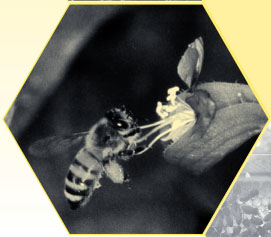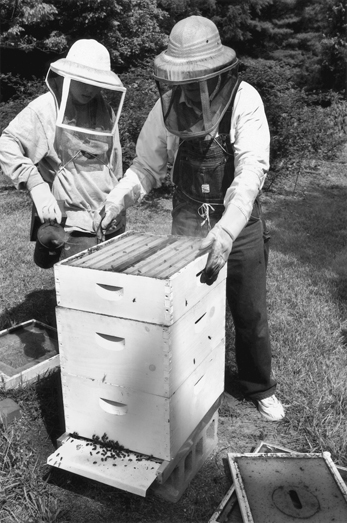
Honeybees have long played an important role in North Carolina's agricultural economy. Vital as pollinators of several major cash crops in the state (especially cotton, alfalfa, fruits, and vegetables) and useful for their production of honey and wax, European honeybees (Apis mellifera) have been a staple of farm life and folk culture for over three centuries.
Native to Europe, Africa, and Asia, honeybees reached North America aboard English vessels as early as 1622. Quickly adapting to the rich flora of the New World, they thrived and spread rapidly. Court records indicate the presence of bees in the Albemarle region as early as 1697. In 1731 the naturalist John Brickell, a resident of Edenton, observed "the Bees are in great Plenty, not only in Hives . . . but are likewise to be met with in several parts of the Woods in hollow Trees, wherein are frequently found vast quantities of Honey, and Wax." Twenty years later the Swedish traveler Peter Kalm, noting the practice of beekeeping among two North Carolina farmers, concluded that "bees succeed very well here."

By the mid-1700s, beeswax, used widely for candles and in cosmetics, became a frequent, if minor, export from North Carolina, while honey generally remained an article of local trade. The colonial government recognized the economic value of beeswax, authorizing its use for taxes under the 1745 Quit Rent and 1768 Tax Acts, at the rate of one shilling per pound.
Requiring little effort and offering high rewards, the practice of beekeeping was well established across the state by 1800. Small farmers and plantation owners alike kept hives, while enslaved people had to forage for the honey produced by feral bee colonies to supplement their rations. The products of the hive played a prominent role in folk medicine, including the use of honey as a salve on burns and bee stings and to treat arthritis. Beekeeping was so ubiquitous that, despite antiquated practices and the Civil War, North Carolina led the nation in production of beeswax and was one of the major producers of honey throughout the nineteenth century.
The early decades of the twentieth century saw a growing awareness of the importance of beekeeping in North Carolina. The state's honey production reached its peak of 2.5 million pounds per year around the turn of the century. The qualities of North Carolina honey varies depending on the local flora, from the light honeys of the basswood in the west and gallberry in the east to the dark honey of the tulip poplar in the piedmont region. The dense, sweet honey of the sourwood, found in the piedmont and western areas, is widely considered a delicacy and commands a substantially higher price than other varieties. In all, bees forage on more than 25 different types of "honey plants" throughout the state.
Though the honeybee was named North Carolina's state insect in 1973, the future of beekeeping has grown less secure as it enters its fourth century in the state. In the early 1990s beekeepers in several western counties reported sharp losses from Tracheal and Varroa mites, parasites for which honeybees have no natural defense. Spread by bees that drift from one colony to another, the mites soon infested colonies across the state with devastating results. According to federal census data, North Carolina beekeepers experienced a drop of almost 50 percent in the number of recorded hives and in honey production between 1987 and 1992, to a level barely above the nadir of 1969; by the early 2000s almost all feral colonies had disappeared. The cessation of the federal honey price support program in 1992 and increasing international competition have placed additional economic stress on the industry. The potential migration into the state of the more aggressive Africanized honeybee from Central America, as far north as Texas by 1996 but by the early 2000s still not moving eastward, may serve to drive all but the most dedicated of beekeepers out of the business, reducing yields and driving up prices of the state's agricultural products.